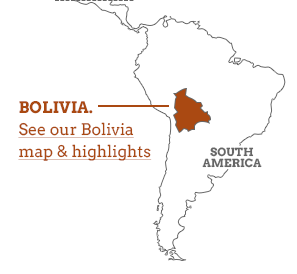A brief history of Bolivia
Long before the Inca Empire crept south from Peru, the Tiwanaku civilisation ruled the Bolivian Andes. The city of Tiwanaku, located between Lake Titicaca and modern day La Paz, was the spiritual center of the empire between 400 and 900 AD; impressive ruins are today a legacy of the astonishing architectural and engineering skills. The empire broke up in 1,000 AD but it was another four centuries before the Inca conquered the region, holding power for just a few decades before being defeated by the Spanish in the 1530s. Bolivia’s extensive silver deposits were soon discovered, and the Spanish flooded in to seek their wealth.
Read more All focus was on Potosí’s mines; indigenous people and African slaves were forced to work in horrific conditions, setting off a sequence of inequality and exploitation which lasted for centuries. Many died after just a few months, due to the toxic fumes, long hours, and months spent underground in intense heat and darkness. To combat the extreme hunger and exhaustion, the indigenous slaves chewed coca leaves. Initially banned by the Spaniards, they soon reinstated it as they realised it allowed the labourers to work harder, longer and on less food. Although coca had been used here for centuries, it under these conditions that it took on the revered status it has to this day, becoming a symbol of the fight of the native people against colonial oppression.
8 million slaves are believed to have died before independence was finally gained in 1825. Bolivia was named after Simon Bolivar, who had led the campaign for independence and created the new country’s constitution. Within 100 years, however, this fledgling nation had lost great slices of territory due to infighting and invasions – including, crucially, its coastline.
Battered by dictators and coups, with foreign powers once again swarming in to take control of its natural resources, Bolivia’s economy remained a disaster. Its geography worsened matters – transportation and infrastructure were not easy to develop. Miners revolted, and military juntas overthrew presidents who overthrew generals who overthrew communist leaders. Resources were privatised, nationalised and privatised again, and the anti-coca campaign plunged already struggling rural communities into severe poverty, with inflation reaching 24,000 percent in 1985.
In 2005, the Movement towards Socialism (MAS) party won the general election, and Evo Morales, became the country’s first indigenous president. A llama farmer and coca grower union leader who was raised in poverty, his election was significant. Interestingly, threats by the US to withdraw aid to Bolivia if they won actually increased support for MAS. Morales nationalised mines and public services, bought back foreign-owned refineries, redistributed land and fought against US and IMF involvement in the country, building partnerships instead with other left-wing Latin American governments. Criticised by both the left and right, and arguably dividing the country more than ever before, Morales has nonetheless managed to cling to power, winning a third term in a landslide majority. With Bolivia’s economy finally recovering, even his critics – overseas and at home – are starting to view the Aymara president as not only anarchic, but astute.




